#venice architecture biennial
Explore tagged Tumblr posts
Text
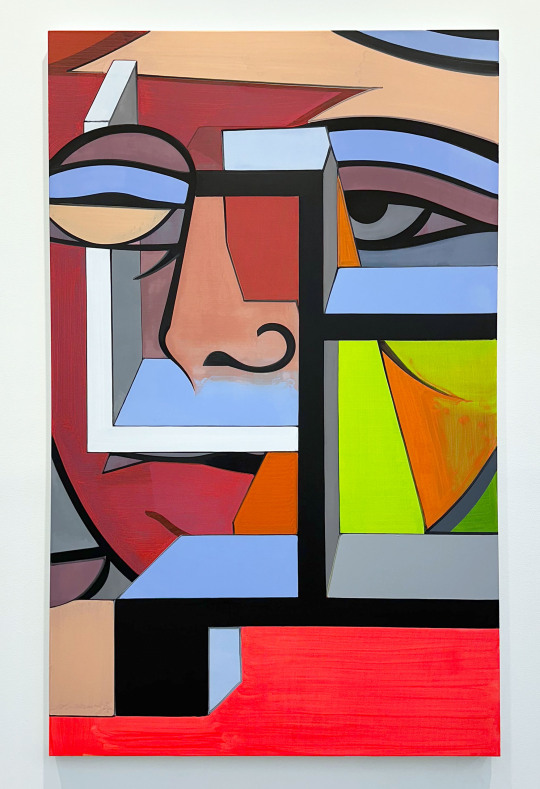
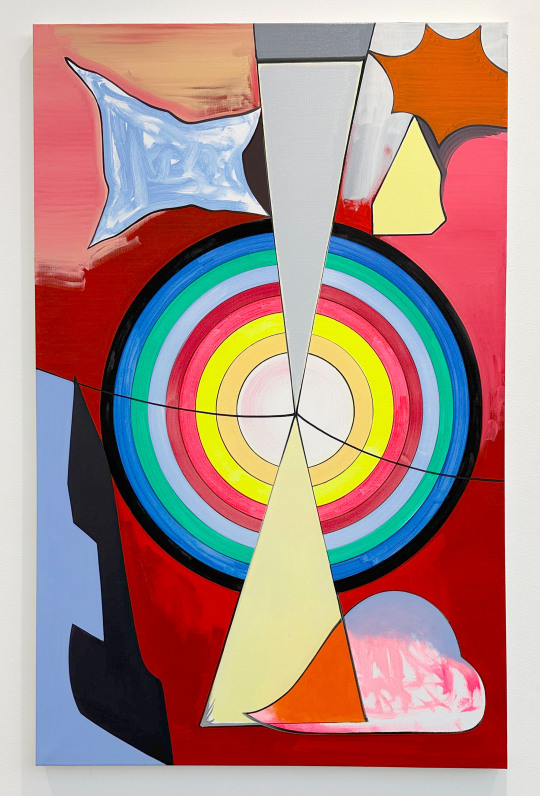


Currently on view at Tanya Bonakdar Gallery is the Thomas Scheibitz exhibition Argos Eyes. The show includes paintings, sculptures, and in the upstairs gallery, a table of tools and objects related to the work.
From the press release-
Internationally renowned for his mastery of painting, Scheibitz subverts traditional notions of the medium with radical juxtapositions of color and a unique formal language that lands ambiguously between abstraction and representation. Drawing from classical painting and architecture, the contemporary urban landscape, and popular culture, Scheibitz deconstructs and recombines signs, images, shapes, and architectural fragments in ways that challenge expected contexts and interpretations.
Scheibitz’s practice has been at the center of contemporary artmaking since the late 1990s with early solo exhibitions at the ICA London, the Stedelijk Museum, Amsterdam, and the Berkeley Art Museum, University of California, Berkeley, as well as breakthrough presentations at the German pavilion of the 51st Venice Biennial, MUDAM Luxembourg, Centre d’Art Contemporain Geneva, Neue Nationalgalerie Berlin, and more recent major shows at Kunstmuseum Bonn, MMK Frankfurt, and Pablo Picasso x Thomas Scheibitz at the Museum Berggruen, Berlin.
In an age of infinite images and visual information, Argos, the multi-eyed, all-seeing guardian giant of Greek mythology, serves as a kind of avatar for Scheibitz. Like the panopticon-esque figure, the artist’s painting and sculpture absorb and dissolve visual material, encoding and decoding, mapping, measuring, penetrating and exploring a pictorial inventory. For Scheibitz, Argos Eyes are the observers of events and circumstances; that which we see directly, or indirectly via our ubiquitous technological devices, lenses, and screens. For the artist, a picture has always been a summary of different sources of observations and experiences which remain in the mind’s eye like “double exposures”. The eye, or by proxy the lens, is the entrance to the conscious or unconscious processing of what we see or do not see. A fundamental question for the artist remains the philosophical question: do we only see what we already know?
In the main ground floor gallery, Scheibitz presents a dynamic range of painterly compositions and a sculpture. Bringing together selections from his vast lexicon of images, Scheibitz builds up these compositions meticulously yet intuitively, using maquettes, drawings, collage, photography, and sketches. Recognizable forms such as eyes, cubes, droplets, and pyramids are translated into multilayered and complex pictorial structures that urge the viewer to consider multiple perspectives.
In the upstairs galleries, more intimately scaled paintings encircle the room, in addition to an Atlas-like master table filled with models, stencils, and other tools representative of the repeated motifs found in the artist’s studio. This conceptual landscape illustrates the core nature of the work, offering interrelated exercises in form, color, and material.
This exhibition closes 4/18/25.
#Thomas Scheibitz#Tanya Bonakdar Gallery NYC#Art#Art Shows#Tanya Bonakdar Gallery#Painting#Sculpture#NYC Art Shows#Chelsea Art Galleries#Chelsea Art Shows#Eyes#Greek Mythology#Mixed Media#Panopticon#Argos#Tanya Bonakdar
2 notes
·
View notes
Text
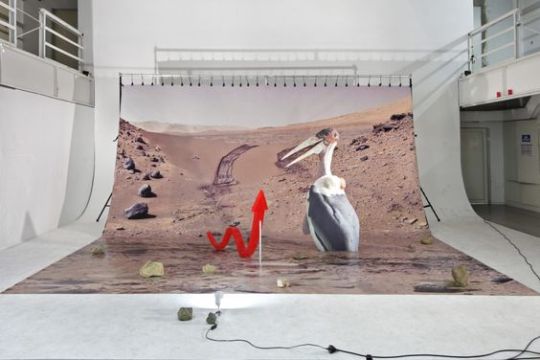
estonianart.ee
Post-Internet and Its Animals
During the current decade, the Estonian pavilion at the Venice Biennial has presented projects dealing with post-Soviet, feminist and queer topics, or has focused on pure aesthetic form while looking back at modernist architecture. This year’s project sits in a fairly recent layer of cultural history and does not trace its roots back to the modernist era, nor is it based on former political rule. Similar to her previous works
5 notes
·
View notes
Text
In Venice, You Can Sip On Espresso Made From the City's Canals
Photo: Iwan Ban This year Biennial Architecture (Architectural Engineering) in Venice, visitors can seize Italian espresso from an unexpected source: city channels. designed by Diller Scofidio + Renfro (DS+R), and Café channel It is an innovative and unique project for the site from the architecture company behind the iconic monuments such as High line In New York City. The installation is “Part…
0 notes
Text

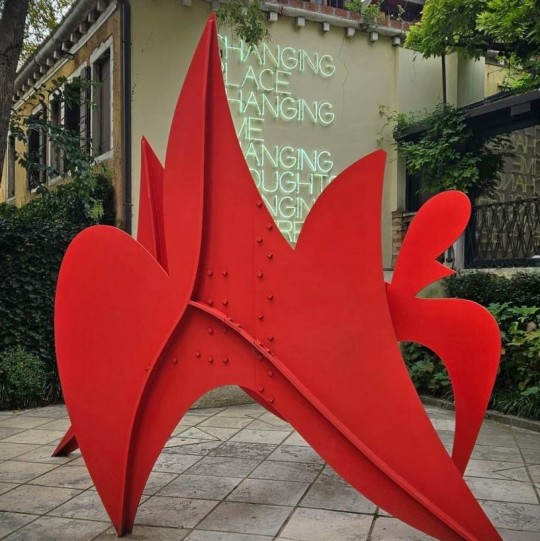

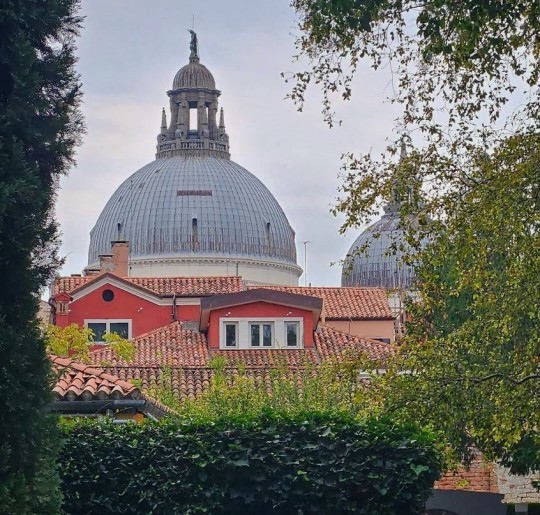
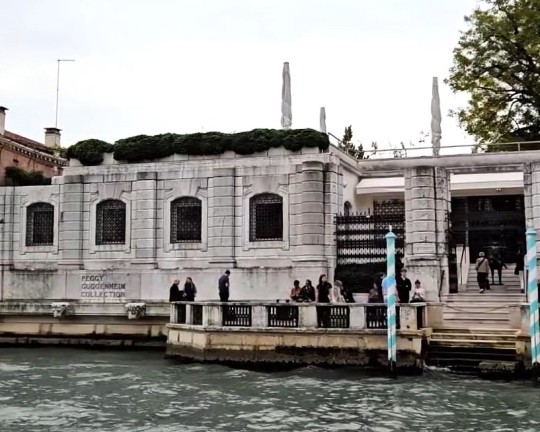

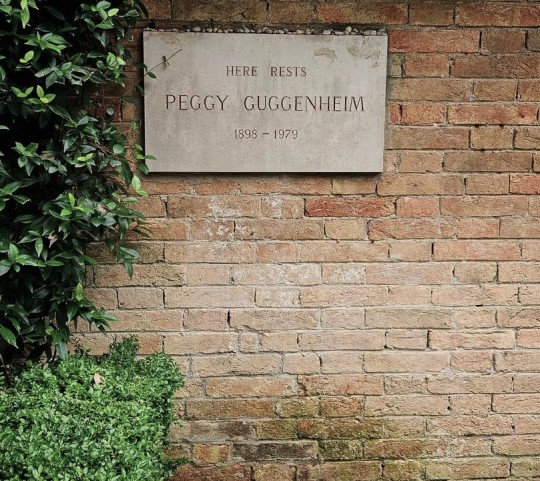
seen at Peggy's place (October 2024)
photos: optikes
Maurizio Nannucci was born in Florence on April 20, 1939. He studied at Florence’s Fine Art Academy and in Berlin before working for many years with experimental theater groups as a set designer. During the first half of the 1960s, he consolidated the basic elements of what would become his visual language by exploring the relationship between art, language, and image, and by creating the first Dattilogrammi, in which words reclaim their strength as symbols. At the same time he was in contact with Fluxus artists, developed an interest for visual poetry, and collaborated with the studio “S 2F M” (Studio di Fonologia Musicale, Florence) to produce electronic music. Nannucci focused on using voices and words to produce sound installations.
In 1967, during his first solo exhibition at the Centro Arte Viva, Trieste, he presented his first neon light texts, thus emphasizing the temporary quality of writing and not the material quality of objects. In 1968 he founded the Exempla publishing house in Florence and Zona Archives Edizioni, both of which published books and catalogues on artists like John Armleder, Robert Filliou, Ian Hamilton Finlay, James Lee Byars, and Sol LeWitt. Nannucci believes that publications and multiples are themselves manifestations of a type of artistic practice that considers art a mental process, one that can be applied to the mass production of everyday objects in order to unify divergent threads in art. The art object may lose its uniqueness, but it gains presence and new freedom.
During the 1990s the artist renewed his interest in the relationship between works of art, architecture, and urban landscape by collaborating with the architects Auer & Weber, Mario Botta, Massimiliano Fuksas, and Renzo Piano. Some of his permanent installations can be seen at the Auditiorium of the Parco Della Musica and Fiumicino airport, both in Rome, and at the Bibliothek des Deutschen Bundestages, Berlin. Nannucci has been a featured artist at the Venice Biennale several times and has participated in Documenta, Kassel, and the São Paulo, Sydney, Istanbul, and Valencia biennials.
Alexander Calder was born July 22, 1898, in Lawnton, Pennsylvania. In 1919, he received an engineering degree from Stevens Institute of Technology, Hoboken. Calder attended the Art Students League, New York, from 1923 to 1925, studying briefly with Boardman Robinson and John Sloan. As a freelance artist for the National Police Gazette in 1925, he spent two weeks sketching at the circus and developed a particular fascination for the subject. He also made his first wire sculpture in 1925, and the following year he made several constructions of animals and figures with wire and wood.
Calder’s first exhibition of paintings took place in 1926 at the Artist’s Gallery, New York. Later that year, he went to Paris and attended the Académie de la Grande Chaumière. In Paris, he met Stanley William Hayter, exhibited at the 1926 Salon des Indépendants, and began giving performances of his miniature circus. The first show of his wire animals and caricature portraits was held at the Weyhe Gallery, New York, in 1928. That same year, he met Joan Miró, who became his lifelong friend. Subsequently, Calder divided his time between France and the United States. In 1929, the Galerie Billiet gave him his first solo show in Paris. He met Frederick Kiesler, Fernand Léger, and Theo van Doesburg and visited Piet Mondrian’s studio in 1930. Calder began to experiment with abstract sculpture and in 1931 and 1932 introduced moving parts into his works. These moving sculptures were called “mobiles,” while his stationary constructions were to be named “stabiles.”
He exhibited with the Abstraction-Création group in Paris in 1933. In 1943, the Museum of Modern Art, New York, gave him a retrospective. During the 1950s, Calder traveled widely and executed Towers (wall mobiles) and Gongs (sound mobiles). He won the Grand Prize for Sculpture at the 1952 Venice Biennale. Late in the decade, the artist worked extensively with gouache. During this period, he executed numerous major public commissions. In 1964–65, the Solomon R. Guggenheim Museum, New York, presented a Calder retrospective. He began the Totems in 1966 and the Animobiles in 1971, both of which are variations on the standing mobile. A Calder exhibition was held at the Whitney Museum of American Art, New York, in 1976. Alexander Calder died November 11, 1976, in New York.
guggenheim-venice.it
0 notes
Text
Stranger research. Doug Aitken
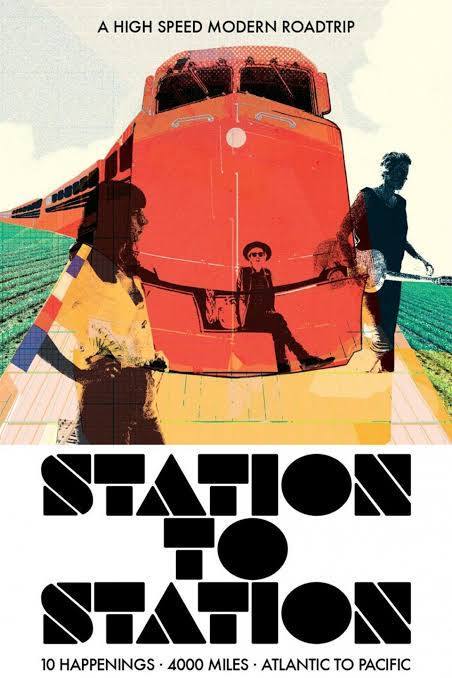
Station to station is a modern cultural collision moving across the U.S. landscape, Station to Station, organized by artist Doug Aitken, was a three-week train ride from New York to California that connected leading figures and underground creators from the worlds of art, music, food, literature, and film.
Doug Aitken is an American artist and filmmaker. Defying definitions of genre, he explores every medium, from film and installations to architectural interventions.
His work has been featured in numerous exhibitions around the world, in such institutions as the Whitney Museum of American Art, The Museum of Modern Art, the Vienna Secession, the Serpentine Gallery in London and the Centre Georges Pompidou in Paris. He participated in the both the 1997 and 2000 Whitney Biennials, and earned the International Prize at the Venice Biennale in 1999 for the installation “electric earth”. Aitken received the 2012 Nam June Paik Art Center Prize, and the 2013 Smithsonian Magazine American Ingenuity Award: Visual Arts. In 2016 he received the Americans for the Arts National Arts Award: Outstanding Contributions to the Arts. In 2017 Aitken became the inaugural recipient of the Frontier Art Prize, a new contemporary art award that supports an artist to pursue bold projects that challenge the boundaries of knowledge and experience to reimagine the future of humanity.
0 notes
Text
Faculty receive promotions in the School of Architecture and Planning
New Post has been published on https://thedigitalinsider.com/faculty-receive-promotions-in-the-school-of-architecture-and-planning/
Faculty receive promotions in the School of Architecture and Planning


Eleven faculty in the MIT School of Architecture and Planning have been recognized with promotions for their significant contributions to the school, effective July 1. Five faculty promotions are in the Department of Urban Studies and Planning; four are in the Department of Architecture; and two are in the program in Media Arts and Sciences.
“Whether architects, urbanists, historians, artists, economists, or aero-astro engineers, they represent our school at its best, in its breadth of inquiry and in its persistence to improve, by design, the relationship between human beings and their environment,” says Hashim Sarkis, dean of the School of Architecture and Planning. “Collectively, they add considerable strength to our faculty.”
Department of Architecture
Azra Akšamija has been promoted to full professor. An artist and architectural historian, she is the director of the Art, Culture, and Technology program. She also directs the Future Heritage Lab. Akšamija is the author of two books, and her artistic work has been exhibited at leading international venues, including the Generali Foundation and Secession in Vienna; Biennials in Venice, Liverpool, Valencia, and Manila; Manifesta 7; museums of contemporary art in Zagreb, Belgrade, and Ljubljana; Sculpture Center and Queens Museum of Art in New York; the Royal Academy of Arts London; and Design Festivals in Milan, Istanbul, Eindhoven, and Amman.
Brandon Clifford has been promoted to associate professor with tenure. Clifford is the director and co-founder of Matter Design, which leverages ancient construction techniques to shape transformative architectural visions. Known for animating megalithic sculptures, he pioneers “projective archaeology,” merging historical events with imaginary futures. Clifford’s speculative works redefine architectural practice, paving the way for new constructive opportunities.
Timothy Hyde has been promoted to full professor. Hyde is an historian of architecture whose research has expanded the understanding of the ways in which entanglements of architecture and law have shaped buildings and cities from the 18th century to the present. In numerous articles, and in books such as “Constitutional Modernism and Ugliness and Judgment,” he has explored buildings — and more recently building sites — in the Americas and in Europe to reveal the participation of architectural discourse in the legal formulation of social techniques of the modern city.
Lawrence “Larry” Sass has been promoted to full professor. Sass is a designer and researcher in the Department of Architecture at MIT. He is a pioneer within the field of design and digital fabrication for low-cost housing. He discovered a low-cost method of single-family home construction using computation and digital fabrication. The impact of his research has been knowledge construction related to the idea that digital fabrication can automate construction. His methods reduce the number of steps in the production of a home. He was the first to publish the idea of digitally fabricated wooden housing in 2006 and exhibited his idea at the Museum of Modern Art in 2008.
Department of Urban Studies and Planning (DUSP)
devin michelle bunten has been promoted to associate professor. Bunten is a teacher, writer, and urban economic theorist. Her research uses economic theory and empirical tools to study a range of urban topics, including gentrification and neighborhood change, restrictive zoning, and the white supremacy at the root of American housing.
Catherine D’Ignazio has been promoted to associate professor. D’Ignazio is a scholar, artist/designer, and “hacker momma” who focuses on feminist technology, data literacy, and civic engagement. She is the director of the Data + Feminism Lab, which uses data and computational methods to work toward gender and racial justice, particularly as they relate to space and place.
Jeffrey Levine has been promoted to associate professor of the practice. Involved in land-use planning on the local and regional level for 25 years, Levine is interested in how to apply best practices in theory and research in local and municipal settings. His research interests are in the areas where public finance, private equity, and land-use planning intersect, as well as how transportation, housing, and sustainability interact in small- to mid-sized cities and regions.
Elisabeth Reynolds has been promoted to professor of the practice. Reynolds’s research is focused on systems of innovation, manufacturing and industrial competitiveness, and regional economic development. Her recent academic and applied work has focused on growing innovative companies to scale, digital technology adoption, and inclusive growth.
Andres Sevtsuk has been promoted to associate professor with tenure. Sevtsuk is the head of the City Design and Development Group in DUSP and director of the City Form Lab. His research focuses on public qualities of cities, and on making urban environments more walkable, sustainable, and equitable, bridging the fields of urban design, spatial analytics, and mobility research. He is the author of the Urban Network Analysis framework and software tools, used by researchers and practitioners around the world to model pedestrian activity in cities and to study coordinated land use and transportation development in ways that reduce transportation carbon emissions.
Program in Media Arts and Sciences
Kent Larson has been promoted to professor of the practice. Larson is an architect, director of City Science at the MIT Media Lab, and co-director of the Norman Foster Institute on Sustainable Cities based in Madrid. His research is focused on urban and architectural design, urban modeling and simulation, transformable micro-housing, living laboratories, ultralight autonomous mobility, and algorithmic dynamic zoning.
Danielle Wood has been promoted to associate professor. Wood is the founding director of the Space Enabled Research group, which seeks to advance justice in Earth’s complex systems using designs enabled by space. Prior to serving on the faculty at MIT, Wood held positions at NASA Headquarters, NASA Goddard Space Flight Center, Aerospace Corp., Johns Hopkins University, and the United Nations Office of Outer Space Affairs.
#ADD#aerospace#Americas#Analysis#Analytics#archaeology#architecture#Art#Culture and Technology#Articles#artists#Arts#author#autonomous#Books#Building#buildings#carbon#carbon emissions#change#cities#Companies#computation#construction#data#data literacy#Design#development#Digital technology
0 notes
Text
Artist Research: Sheila Hicks
“I don’t want to go do something I know how to do. I want to go do something I don’t know how to do.” - Sheila Hicks
Sheila Hicks (born 1934) is an American artist. She is known for her innovative and experimental weavings and sculptural textile art that incorporate distinctive colors, natural materials, and personal narratives.
Her diverse approach to textiles put her at the center of the burgeoning Fiber Art movement of the 1960s and ’70s, in which artists, including Lenore Tawney and Magdalena Abakanowicz, were inventing new possibilities for pliable mediums. They created sculptural and three-dimensional fiber works that upended conventions, establishing a new order in the largely male-dominated arena of two-dimensional tapestry-making.
Hicks continues employing intensely saturated color and the raw materials of textiles—wool, synthetic thread, linen flax—in works that are rigorously constructed by wrapping, piling, and weaving her materials. “I don’t want to go do something I know how to do. I want to go do something I don’t know how to do,” she has said. “I don’t want a legacy. I just want to have fun while I’m here.”

Sheila Hicks explores the vibrant possibilities of thread as she crafts wall-mounted textiles, hanging and floor-based sculptures, and monumental installations. While her exuberant palette and keen understanding of color link her work to painting, Hicks has helped propel textile arts, soft sculpture, and modes of traditionally underappreciated women’s work.
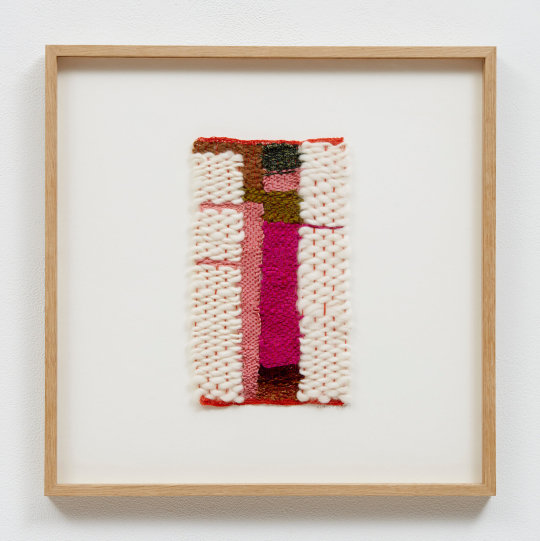
Sheila hicks is one of my favourite artists with her innovative and creative textile work. Her work ranges from small wall hangings, to enormous site-specific pieces and her work blurs the distinction between art and craft. “Textile had been relegated to a secondary role in our society, to a material that was considered either functional or decorative. I wanted to give it another status and show what an artist can do with these incredible materials.” Sheila Hicks learned to sew from her grandmother at a very early age and went on to study under Josef Albers, instructor at the Bauhaus and Yale University School of Art and Architecture. Hicks’ work has been featured in the 2014 Whitney Biennial and the 2017 Venice Biennale.
youtube
0 notes
Text
Helen Thomas: Architecture In Islamic Countries
Selections from the Catalogue for the Second International Exhibition of Architecture Venice 1982/83, edited by Helen Thomas.
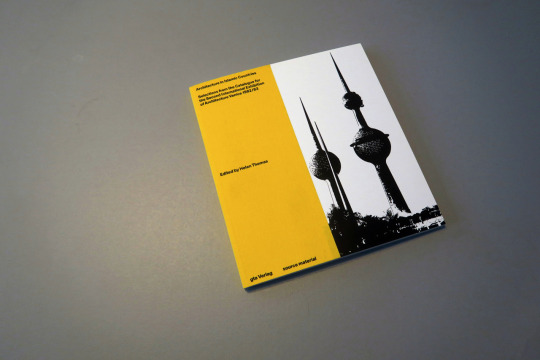
If you are familiar with this website, you might remember an extensive survey of the Venice Biennale of Architecture - Cold Cases where no less than fourteen authors went back to the history of the institution and shared their experiences and actual thoughts.
Exhibitions are a strange thing: they exist for a few weeks or months, then get dismantled and disappear forever. What is left are the publications, reviews in magazines or the Internet, and recollections in the mind of visitors. But catalogues get out of print, Internet pages are closing and memories vanish or get embellished. Therefore, when we discuss an exhibition, we often comment on a few black and white photos (especially before the rise of digital imagery) and texts found in libraries. Luckily, some academics dedicate their efforts to extensive research and give us a possibility to approach the concepts, questions, and debates that filled an exhibition. Following that principle, the book Architecture in Islamic Countries is a chance to discover the second Architecture Venice Biennial and to examine the early 1980s discourse.
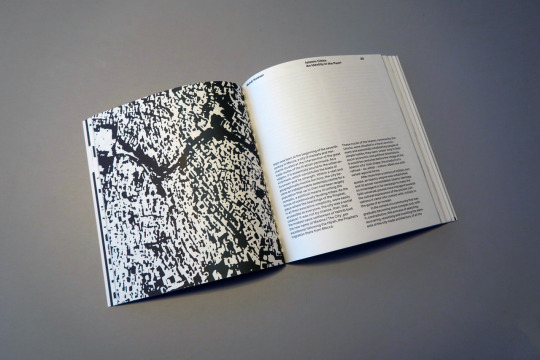

The volume offers a reprint of three original essays by Paolo Portoghesi, Mehdi Kowsar and Udo Kultermann published in Italian for the catalogue of 1983 and translated here into English for the first time. Helen Thomas, Esra Akcan, Aslı Çiçek and Véronique Patteuw delve into those historical texts and documents to examine their relevance today. Obviously, postmodernity is a dispute that has lasted and might seem behind us, while its aftermath – regionalism – has left disgusting marks in cities all over the world. But colonialism and post-colonialism are words that find resonance in many actual debates, and this edition of the Venice Biennial was loaded with those concepts. That second edition of the Biennial, in opposition to the first one, it was not about the restoration of ornaments, the (bad) taste or the return of fun into modernity. It was about a world that slowly gets globalised and a search for cultural roots in architecture. That makes this book a great reading, as the original texts are commented with a critical eye, commenting on the ideological and political positions of the actors from the biennale. (Akcan, for example, beautifully brings back the ‘fight’ that Bruno Zevi initiated in the press towards the biennial and its ideas…)
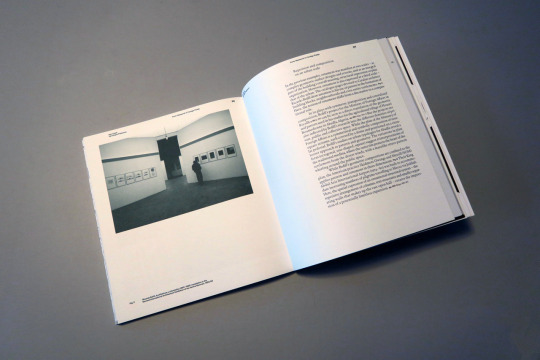
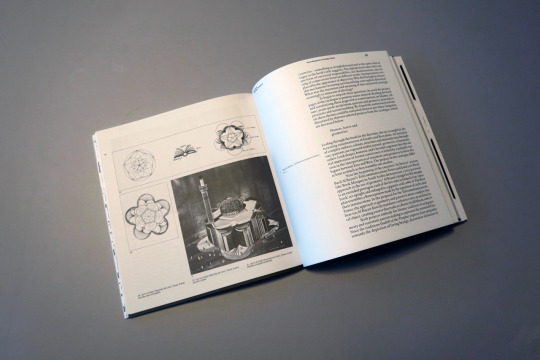
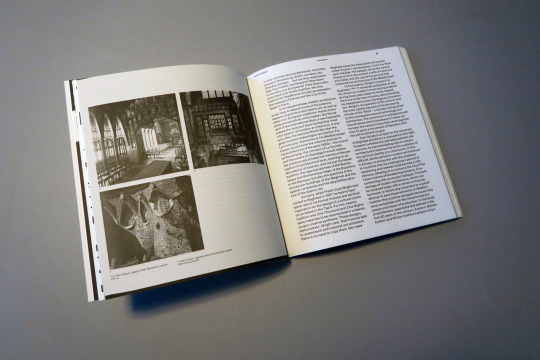
But what do we really learn here? That an exhibition that was not so well received at her time can become highly relevant 40 years later. Those questions that were (a bit) naively asked in the 1980s are still looking for an answer. That discussing the role of pure geometry in architecture (in an era of 3D nurbs and impossible shapes) could be something new. Last but not least, we realise that history is not written once and forever, and that we can always look at events, exhibitions or buildings from the past with a fresh eye.
-
Thibaut de Ruyter
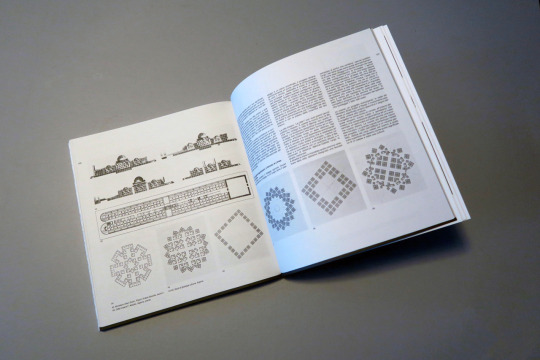
Architecture in Islamic Countries; Selections from the Catalogue for the Second International Exhibition of Architecture Venice 1982/83, Edited by Helen Thomas; gta Verlag - source material, 2022
1 note
·
View note
Text
Powerhouse Museum
EXHIBITION
Atmospheric
Memory
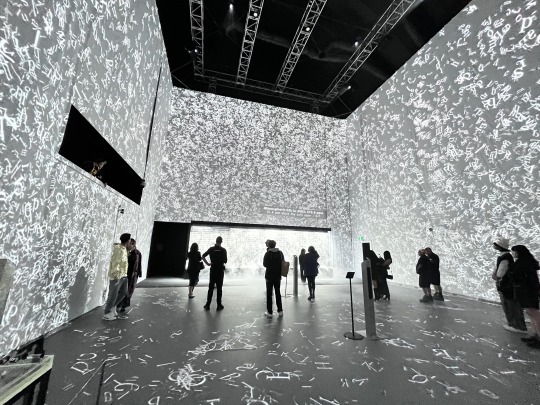
Artist
Rafael Lozano-Hemmer is a media artist working with ideas from architecture and performance. He was the first artist to officially represent Mexico at the Venice Biennale with a monographic exhibition in 2007.
He has also shown at Biennials such as Havana, Istanbul, Kochi, Liverpool, Mercosul, Shanghai, Singapore, Sydney.
Lozano-Hemmer was the subject of 75 solo exhibitions worldwide, including a major show at the Hirshhorn Museum in Washington DC, the inaugural show at the AmorePacific Museum in Seoul and a mid-career retrospective co-produced by the MAC in Montréal and SFMOMA.
In 2019, his interactive installation Border Tuner connected people across the US-Mexico border using bridges of light controlled by the voices of participants.
https://powerhouse.com.au/program/atmospheric-memory?gclid=CjwKCAjwjaWoBhAmEiwAXz8DBS9q-mlDaIIj9dHyPeH5Xu9ur_mC8f_e6HV8Ij_ByAQXh6v0ToV4XRoCnqMQAvD_BwE#curator
In this exhibition, I heard and saw many sounds that could not be heard or seen, as well as a series of interactive sound installations. There are 3D printed speech bubbles and see your voice travel through the corrugated grooves. There is a simulated lung breathing device, which allows visitors to experience the number of contractions of the lungs in a day through a plastic tube and a paper bag.
Here is a recording of a simulated lung breathing device.
1 note
·
View note
Photo
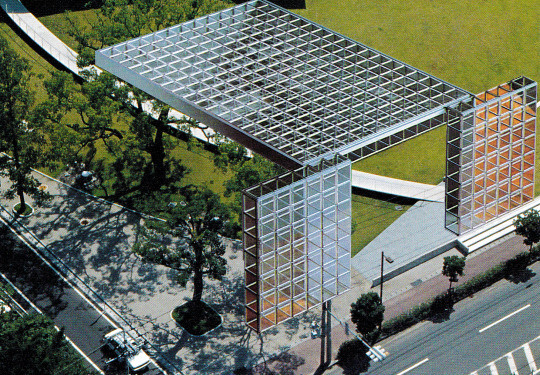
“Yatsushiro Pavilion”, Kumamoto Prefecture, Japan _ 25.07.2022 _ SK
Architect / Design: Jean Nouvel, French Pavilion, 44th Venice Biennial, Italy (1990).
http://www.jeannouvel.com/en/projects/pavillon-francais-de-la-biennale/
Teramatsu, Y. (1995) The Japan Architect; No. 17, Spring 1995-1, Tokyo: Shinkenchiku-Sha Co. Ltd.
#Yatsushiro Pavilion#Kumamoto#Japan#Jean Nouvel#French Pavilion#44th Venice Biennial#Italy#1990#The Japan Architect#Anatopism#Collage#Architecture#Spyros Kaprinis#2022
2 notes
·
View notes
Photo



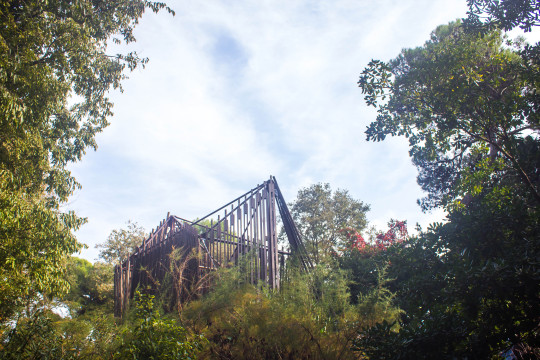

Vatican Chapels, Isola di San Giorgio Maggiore, Venezia. Biennale Architettura, 2018. In frame: @comeifiorivelenosi
#vatican chapels#Architecture#san giorgio maggiore#venezia#venice#biennale#biennale architettura#architettura#cappelle#vaticane#chiese#church#biennial#arch
9 notes
·
View notes
Photo


DIALOGUES - Proposal for Slovenian Pavillion at 2020 Venice Architecture Biennial. Together with architect Tamara Németh and designer and curator Dorotea Škrabo.
Take a look at the booklet here: https://drive.google.com/file/d/1AZfed99UHVl4F6dWcupTvy1gn0ciGtPn/view?usp=sharing
0 notes
Text
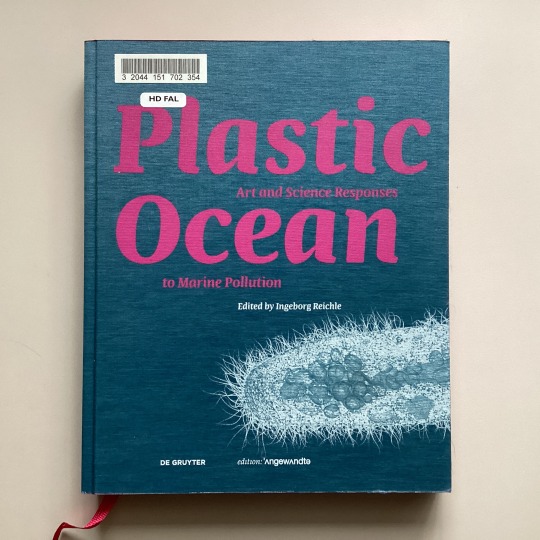
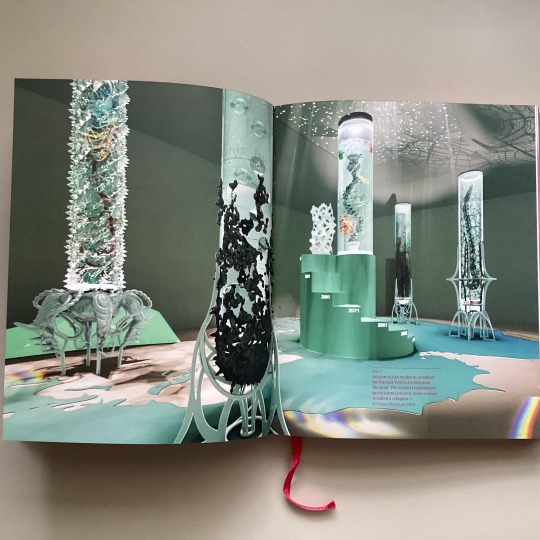
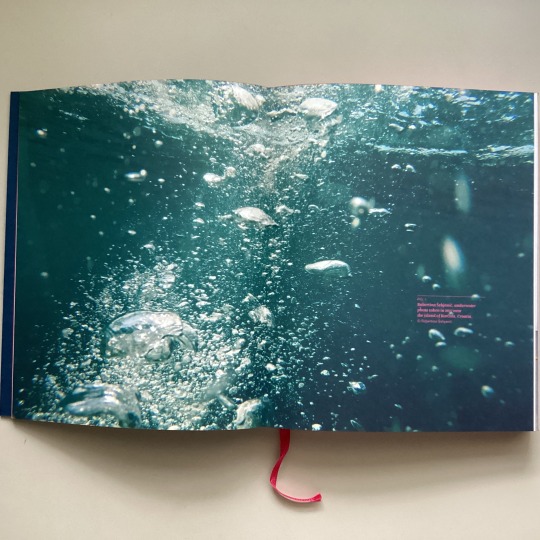
Today is World Oceans Day. After decades of pollutions by humans, the world’s oceans are on the tipping point for collapse with millions of tons of toxic microplastic particles. In just a few years, the volume of microplastic particles will exceed that of plankton, turning our oceans into a huge sea of plastic. This publication entitled “Plastic Ocean: Art and Science Responses to Marine Pollution” brings together numerous international art projects related to environmental activities and offers an interdisciplinary perspective across the arts and a wide range of disciplines, sounding the alarm about this ecological crisis.
Image 1: Front cover
Image 2: “Hollow Ocean” render as installed for the 2021 Venice Architecture Biennial. The ocean is represented as six water columns. Each column is called a “chapter.” Yoldas StudioLab. 2020
Image 3: Underwater photo taken in 2017 near the island of Korčula, Croatia. Kobertina Šebjanič.
Plastic ocean : art and science responses to marine pollution Edited by Ingeborg Reichle ; with contributions by Brandon Ballengée [and seventeen others]. Berlin ; Boston : De Gruyter, [2021] Edition Die Angewandte, University Press HOLLIS number: 99155758658903941
#WorldOceanDay#ArtandScience#PlasticOcean#HarvardFineArtsLibrary#Fineartslibrary#Harvard#harvard library#harvardfineartslib#harvardlibrary#worldoceansday
10 notes
·
View notes
Photo

Simone Leigh: Sovereignty
USA Pavilion at Venice Biennial 2022
The 59th International Art Exhibition will take place from 23 April to 27 November 2022 in Venice, Italy.
Simone Leigh: Sovereignty features a new body of work made for the United States Pavilion, in Venice Italy. Her large-scale sculptural works join forms derived from vernacular architecture and the female body, rendering them via materials and processes associated with the artistic traditions of Africa and the African diaspora. Sovereignty commingles disparate histories and narratives, including those related to ritual performances of the Baga peoples in Guinea, early Black American material culture from the Edgefield District in South Carolina, and the landmark 1931 Paris Colonial Exposition.
With a series of new bronzes and ceramics both outside and inside the Pavilion, Leigh intervenes imaginatively to fill gaps in the historical record by proposing new hybridities.
More information here
2 notes
·
View notes
Photo

Out of the many noteworthy pavilions at the grounds of the Venice Biennial Sverre Fehn‘s Nordic Pavilion has long been revered as one of the most fascinating and beautiful. Designed around existing trees with a distinct concrete roof construction it is an early display of Sverre Fehn's sensible understanding of architecture. Although he had won the competition for the pavilion already in 1958 it took until 1962 for it to finally be opened. preceded by long discussions, political quarrels and administrative dodges. Foregoing were intense discussions, geopolitical considerations and administrative dodges as the present book reveals: Mari Lending and Erik Langdalen's "Sverre Fehn, Nordic Pavilion, Venice - Voices from the Archives", recently published by Lars Müller Publishers. Based on extensive archival research the authors tell the thrilling story of the pavilion not exclusively as an architectural history but also one that includes all the deliberations going on in the backrooms of politics. This was mainly due to the fact that the pavilion was a joint project of the Nordic countries (that is effectively Norway, Sweden and Finland) that intrinsically entailed the balancing of powers and demands of three independent nations. This complex genesis is reflected in Lending and Langdalen minutiously detailed recount of how the decision making processes on both the political and architectural level until the pavilion’s opening worked, a story involving an incalculable number of people from the architect to artists’ associations, gardeners to plumbers. In addition the book also features a number of short essays addressing, in retrospect, topics like the pavilion’s relation to Venetian topography or the particular quality of the concrete used. With this all-encompassing approach and their meticulous archival research the authors succeed in writing the highly readable history of Sverre Fehn’s epochal building that both embeds it in its time and portrays its aftermath. Hopefully the book sets a precedent for research into the history of all the other notable Biennial pavilions in Venice. A highly recommended read!
#sverre fehn#biennale di venezia#architecture#norway#nordic pavilion#architecture book#book#lars muller publishers#exhibition pavilion
26 notes
·
View notes